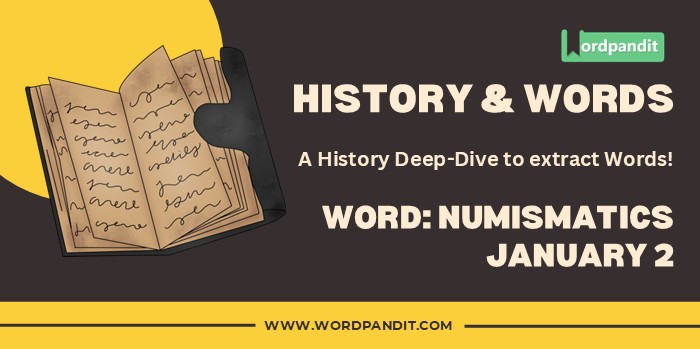History & Words: ‘Numismatics’ (January 2)
Welcome to ‘History & Words.’ 🌟 I’m Prashant, founder of Wordpandit and the Learning Inc. Network. This series combines my passion for language learning with historical context. Each entry explores a word’s significance on a specific date, enhancing vocabulary while deepening understanding of history. Join me in this journey of words through time.
📚 Table of Contents
🔍 Word of the Day: Numismatics
Pronunciation: /ˌnjuːmɪzˈmætɪks/ (noo-miz-MAT-iks)
🌍 Introduction
On January 2, 1909, the United States Mint began production of the Lincoln cent, marking a pivotal moment in American numismatic history. This event represented the first time a real person’s likeness appeared on a regular-issue U.S. coin, breaking with the tradition of using symbolic figures of Liberty.
The word “numismatics” encompasses far more than mere coin collecting—it represents the systematic study of currency in all its forms, including coins, tokens, paper money, and related objects. This scientific discipline combines elements of history, art, economics, and metallurgy to understand human civilization through its monetary artifacts.
The Lincoln cent’s introduction exemplifies how numismatics connects us to significant historical transitions, reflecting changing social values and commemorative practices in currency design.
🌱 Etymology
The term “numismatics” derives from the Late Latin “numisma” and Greek “nomisma,” meaning “current coin” or “custom.” These words ultimately trace back to the Greek “nomos,” meaning “usage” or “custom,” reflecting how currency emerged from standardized trading practices in ancient civilizations.
📖 Key Vocabulary
- 🔑 Numismatist: A person who studies or collects coins, paper currency, and medals
- 🔑 Mintage: The action of minting coins or the number of coins minted in a particular issue
- 🔑 Die: A specialized tool used in manufacturing to cut or shape materials using a press
- 🔑 Proof: A specially made coin with a mirror-like finish, struck multiple times for collectors
- 🔑 Obverse/Reverse: The front (“heads”) and back (“tails”) of a coin, respectively
🏛️ Historical Context
The study of coins and currency dates back to ancient times, with evidence of coin collecting found in ancient Rome. However, numismatics as a systematic academic discipline emerged during the Renaissance, when scholars began studying ancient coins to better understand classical civilization.
The 18th and 19th centuries saw numismatics evolve from a hobby of aristocrats into a scientific field. The establishment of national coin cabinets and museums, along with the development of standardized cataloging systems, transformed casual collecting into serious scholarship.
The democratization of coin collecting accelerated in the early 20th century, coinciding with the Lincoln cent’s introduction. This period saw the emergence of organized numismatic societies and publications, making the field more accessible to the general public.
⏳ Timeline
- Ancient times: First evidence of organized coin collecting in Rome
- 14th-15th centuries: Renaissance scholars begin systematic study of ancient coins
- 1792: U.S. Mint established
- 1857: First major U.S. numismatic society founded
- 1909: Lincoln cent introduced (January 2)
- 1962: First computerized numismatic catalog system developed
- 1984: American Numismatic Association Money Museum opens
🌟 The Day’s Significance
January 2, 1909, marked a watershed moment in American numismatic history. The Lincoln cent’s introduction broke with the long-standing tradition of avoiding portraits of real people on circulating U.S. coins, a practice that had stemmed from the nation’s republican values.
The decision to feature Abraham Lincoln was timed to coincide with the centennial of his birth in 1909. Designer Victor David Brenner created an iconic portrait that would become the longest-running design in U.S. coinage history.
This numismatic milestone sparked increased public interest in coin collecting and studying monetary history. The Lincoln cent’s introduction also established a precedent for commemorating historical figures on American currency, influencing future coin designs.
🔮 Modern Usage and Reflection
Today, numismatics encompasses both traditional coin collecting and the study of digital currencies. Modern numismatists use advanced technology for authentication and preservation while exploring how cryptocurrency might influence future currency evolution.
The field continues to provide valuable insights into economic history, artistic development, and technological innovation. Numismatic studies help us understand patterns of trade, cultural exchange, and social development throughout human history.
🏛️ Legacy
The scientific approach developed by numismatists has influenced other fields of historical study, particularly in dating artifacts and tracing trade routes. Numismatic research continues to uncover new information about ancient economies and social structures.
The discipline has also contributed significantly to preservation techniques and authentication methods used across multiple fields of historical study.
🔍 Comparative Analysis
Early numismatics was primarily concerned with coins as historical artifacts, focusing on their artistic and material value. Scholars used coins to study the artistic styles, ruling figures, and metallurgical techniques of different eras.
Modern numismatics takes a broader approach, incorporating the study of economic systems, trade networks, and cultural exchange. This expanded perspective allows numismatists to connect the evolution of currency with broader historical and societal trends, such as the rise of empires, technological advancements, and global economic integration.
Furthermore, the advent of digital currencies has introduced new dimensions to the field, prompting comparisons between traditional physical currencies and modern virtual ones. Numismatics today is as much about the future of money as it is about its past.
💬 Quote
“In coins, we read the past and glimpse the future of human civilization.” – Elvira Clain-Stefanelli, former curator of the National Numismatic Collection
💡 Did You Know?
🎓 Conclusion
Numismatics represents far more than the study of coins—it provides a unique lens through which we can examine human civilization’s development. From ancient trade routes to modern digital currencies, the field continues to evolve while maintaining its core focus on understanding humanity through its monetary artifacts.
📚 Further Reading
- 📘 “100 Greatest Ancient Coins” by Harlan J. Berk
- 📗 “The Lincoln Cent: A Collection for the First 100 Years” by Charles D. Daughtrey
- 📙 “Perspectives in Numismatics: Studies Presented to the Chicago Coin Club” edited by Saul B. Needleman











